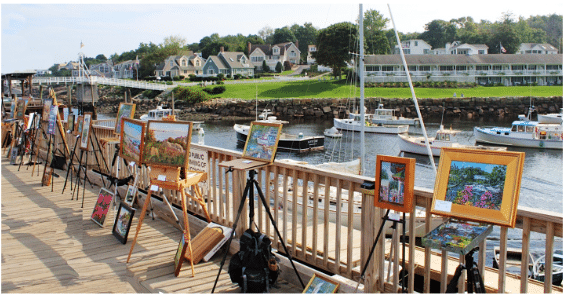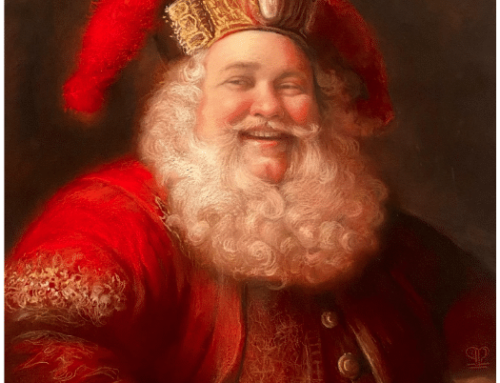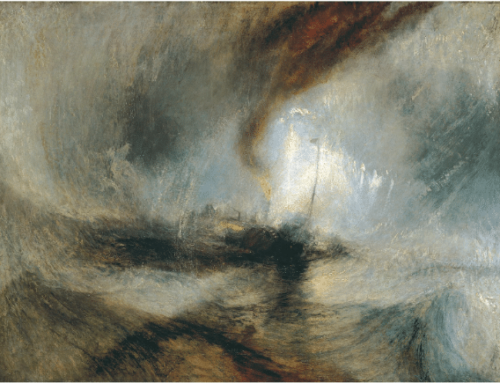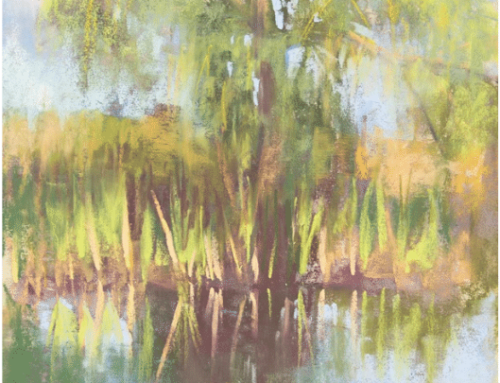Think plein air in Maine, and chances are you’ll think “Monhegan.” But before that rock-bound island community took the crown, another and more accessible locale was king – the southern Maine town of Ogunquit, which in the Abenaki tongue means “beautiful place by the sea.”
Ogunquit was once a magnet for artists, a thriving creative enclave that won it, at the turn of the 20th century, the title of one of the most renowned sites for plein air painting in America. Ogunquit can boast that literally tens of thousands of artists and students painted and took classes there between the 1890s and the mid twentieth century. Prominent seascapist Charles Woodbury bought land nearby its picturesque fishing shacks and piers, and in 1897 opened his “Summer School of Art,” the first major outdoor painting school in the country. The popularity of the school, and the influx of artists, grew the place into one of Maine’s top resort towns.
The town and its resort-like vibe remain, but until recently, there hasn’t been much visible evidence that once upon a time, dozens of artists painted in the picturesque inlet of Ogunquit’s Perkins Cove each summer.
“I just wondered where all the artists went,” Jen Lewer says, “and how we could get them back.” Lewer is a member of Parks and Recreation for the Town of Ogunquit, which is hosting the event. She missed seeing the groups of outdoor painters that used to sell their work there and had an idea for what to do about it. Woodbury’s original studio, now a private residence, still watches over the cove.
Lewer put heads together with fellow Parks and Rec member Amy Forbes and involved local artists David and Pam Lussier, veterans of the plein air event world since the early 2000s. Now in its fourth year, the annual September “Perkins Cove Plein Air” event September 7, 2024 will host over 100 professional and amateur plein air artists, with a healthy waiting list to boot.
Artists can paint anywhere “in the Cove” and bring an additional painting for sale. A competition awards $6,000 in prizes, and usually there’s an art talk by someone familiar with plein air and perhaps the history of the Ogunquit Art Colony.
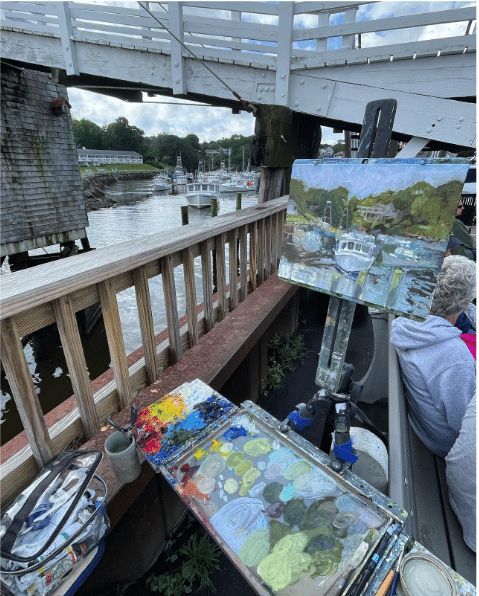
Artist Christy Hegarty found a painting perch at the base of “the footbridge,” a major Perkins Cove landmark spanning the waterway that connects the boat-laden Cove with the ocean.
The event builds on a revival of the Perkins Cove art scene that began in 2013 when artist and teacher Todd Bonita established a new outdoor painting school providing weekly classes and workshops in Ogunquit and the New Hampshire seacoast year-round. Bonita snagged the ogunquitartcolony.com URL and began inviting regional and soon nationally recognized visiting artists to teach week-long workshops. Most recently he’s added destination workshops in locales such as Monhegan, Ireland, Tuscany, and Paris, France.
Plein air in Perkins Cove Plein Air may seem new to most, but it’s well on its way to putting Ogunquit back onto the national plein air map. Each year’s September Perkins Cove Plein Air event draws a larger number of applicants and more local interest.
“The impression that you get from people is that, because it’s not a high-pressure event, people really enjoy it,” Pam Lussier says. “It’s beautiful, it’s not five days long, there’s no one timing you, everyone’s having fun. The whole idea was to bring the joy to a plein air painting event – and they’ve done it!”
Live too far away to attend the Ogunquit Summer School of Art? There’s always your backyard! Study at home and browse dozens of professional-grade teaching videos on plein air painting right here.
If you’re interested in learning more about the Perkins Cove event, check out ogunquitperkinscovepleinair.com. There’s also a Facebook group for interest in Ogunquit art and photography.
What Makes a Painting ‘Work’?
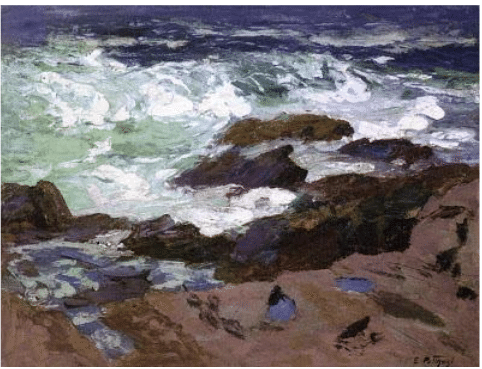
Wild Surf at Ogunquit by Edward Henry Potthast
Here’s a painting of the crashing surf and rocks in Ogunquit, Maine by Edward Henry Potthast, an American Impressionist popular around the turn of the 20th century. There are plenty of paintings of crashing surf and rocks in the world, but this one happens to “work” quite well.
When we say something “works,” the underlying metaphor is the machine. A machine works when each of its components fulfills its purpose, and all contribute to the successful functioning of the whole.
Okay, it works. Why? What are some of the “moving parts” involved in the painting above, titled Wild Surf at Ogunquit?
Perhaps it’s the loose, juicy paint handling – the big fluid strokes are particularly well suited to the subject of wild waves rushing between jagged rocks.
Maybe it’s the design. There’s a circular composition “hidden” here – it’s not obvious because the circle is broken, but it begins with the sweeping horseshoe of the foreground rocks. The eyes follow that “U” curve of rocks into the upper arc of the waves that completes the round circuit. That active repetitive motion is not unlike what the actual seawater and surf does too – circling around, churning in and out of the rocks.
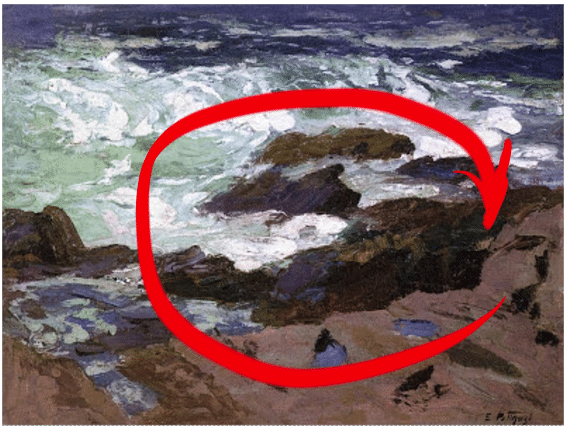
For that matter, there’s a wild counterpoint in the middle ground between the brushstrokes that follow the planes of the rocks and those that define the breaking waves.
What about the color? The cool deep blues and frothy greens convince us we’re experiencing the bracing Atlantic coast. I keep coming back to those fluffy blobs of white paint in the foam, the ambiguous dabs of muted cobalt and ochre in the rocks, and the rich tones of blue and green in the waves farther out.
The tactile paint handling, the strong contrasts, the predominantly cool palette, and the endlessly cycling circularity in motion, combine to express a strong and satisfying sense of the rough, restless ocean at its endless work.
Such a painting either “works” to a sufficient degree or not based on how the parts relate to themselves and contribute to a central feeling or idea. But who knows, really? We know this much: great art cannot be reduced to any absolute formula.
Still, questioning what moves us about a work of art deepens our appreciation and serves us well as we look at other paintings or attempt our own. So why do you think the Potthast works?
If you’d like to brush up on your seascape skills, why not check out one of these videos?
And if designing powerful paintings is your goal, browse through numerous videos on composition and design right here.

